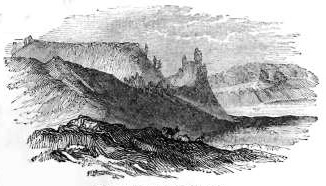The Battle of Dundalk

Rath at Leighlin, Carlow
The Battle of Dundalk—The Danes supposed to be Christianized—Brian Boroimhé and his Brother Mahoun—The Dalcassians fight the Danes—Mahoun is assassinated—Brian revenges his Brother's Murder—Malachy's Exploits against the Danes—Malachy and Brian form a Treaty and fight the Danes—Malachy wins "the Collar of Gold"—Brian's "Happy Family" at Kincora—He usurps the Supreme Power, and becomes Monarch of Ireland—Remote Causes of the Battle of Clontarf—Gormflaith is "grim" with Brian—Blockade of Dublin—The Danes prepare for a Pierce Conflict—Brian prepares also—The Battle of Clontarf—Disposition of the Forces—Brian's Death—Defeat of the Danes.
[A.D. 926—1022.]

ANY of the sea-coast towns were now in possession of the Danes. They had founded Limerick, and, indeed, Wexford and Waterford almost owe them the debt of parentage. Obviously, the ports were their grand securities—a ready refuge if driven by native valour to embark in their fleets; convenient head-quarters when marauding expeditions to England or Scotland were in preparation. But the Danes never obtained the same power in Ireland as in the sister country. The domestic dissensions of the men of Erinn, ruinous as they were to the nation, gave it at least the advantage of having a brave and resolute body of men always in arms, and ready to face the foe at a moment's notice, when no selfish policy interfered. In 937 Athelstane gained his famous victory over the Danes at Brunanbriegh in Northumberland, and came triumphantly to reclaim the dagger [1] which he had left at the shrine of St. John of Beverley. After his death, in 941, Amlaff returned to Northumberland, and once more restored the Danish sway. From this time, until the accession of the Danish King Canute, England was more or less under the dominion of these ruthless tyrants.[2]
"The Danes of Ireland, at this period, were ruled by Sitric, son of Turgesius, whose name was sufficient to inspire the Irish with terror. Through policy he professed willingness to enter into a treaty of peace with Callaghan, King of Munster; and, as proof of his sincerity, offered him his sister, the Princess Royal of Denmark, in marriage. The Irish king had fallen in love with this amiable and beautiful princess, and he readily consented to the fair and liberal measures proposed. He sent word to Sitric he would visit him; and, attended by a royal retinue, to be followed in a little time by his guards, as escort for his future queen, proceeded to meet his royal bride.
Notes
[1] Dagger.—The king visited the shrine on his way to battle, and hanging up his dagger, the then symbol of knightly valour, vowed to release it with a kingly ransom if God gave him the victory. He obtained his desire, and nobly fulfilled his vow.
